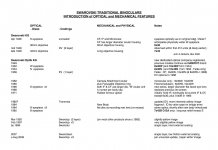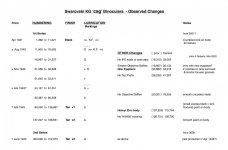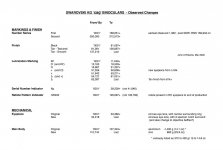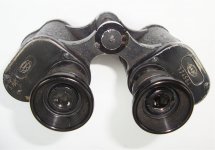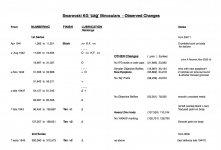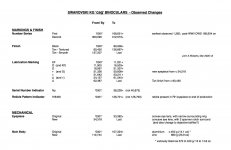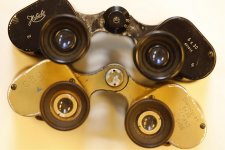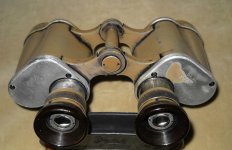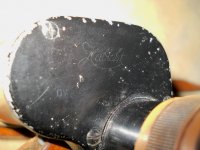Hi Telebin,
Firstly, a big welcome to Bird Forum
Secondly, your comments about early Swarovski binoculars raise a number of interesting points
A) Overview
For a quick overview, see post #18 and following (including the tables linked to in post #31) at:
https://www.birdforum.net/showthread.php?p=3954694#post3954694
And for more detail about changes and variations to the Traditional series Porro prisms from 1948 on, see the attached table
B) WWII Military Production
Prior to WWII Swarovski did not make binoculars but specialised in making crystals for the jewellery trade
In 1939 it established an optics department and commenced to manufacture spectacle lens blanks
However during the war, production was entirely devoted to military needs
The main product was the standard pattern 6x30 Dienstglas i.e. the military version of the Zeiss Silvarem IF binocular
Production was from April 1941 to around late-1944, with around 183,000 units delivered to the military *
The units were marked with the three letter code 'cag' to identify them as Swarovski production
Various on-line posts indicate that Swarovski produced around 18% of the total 6x30’s (However, I’ve not seen any indication as to the source of the information)
And for a lot more detail see the two attached tables. For convenience, I’ve sorted the information both chronologically and by features
Additionally, in 1943 Swarovski also manufactured another product, the ZF 41/1. It was a 1.5x11mm intermediate eye relief telescopic sight
Production exceeded 4,000 units which were also marked cag
See Ken Tomon’s comprehensive coverage at:
http://zielfernrohr.b.la9.jp/zielfernrohr_021.htm
* In late April 1945 Swarovski had on hand an order for 5,000 Dienstglas that were still being worked on
As the formal German surrender was on 7th May, this additional production would have formed a substantial part of the post-WWII DWS marked units
See slide #18 in Gijs’ Power Point presentation ‘History and quality development of Swarovski Optik 1935-present time’ at:
https://www.houseofoutdoor.com/verrekijkers/verrekijkers-testen-en-vergelijken/
C) Early Post-WWII Activity
Following the end of the war, in late 1945 Swarovski recommenced spectacle lens production, and also established the ‘Vocational School for Opticians’ locally in Solbad Hall
After the war years there would have been a large civilian demand for such a product
When Swarovski was able to officially recommence binocular production/ commence commercial sales in 1948, they:
- sold slightly modified cag units which were marked DWS *
(perhaps 10,000 units in all: the observed numbering is from 169,934 to 178,434, which continued on from the first cag numbering sequence that went to at least 168,651), and
- all new production as referred to in A) above
The former were mainly sold to Allied occupation forces, and the later were primarily for export
* See the image of a DWS unit to compare to the images provided by Jan van Daalen in post #21 in the link attached to A) above
The image is from Frank (aka LPT on Bird Forum) at:
https://www.flickr.com/photos/binocwpg/25672077691
D) Early Lens Coatings
All of Swarovski's WWII military production was uncoated, as were the post-WWII DWS marked units
However, all but the very earliest new commercial production in 1948 had the recognisable dual layer DV coating *
Dual layer coating continued on the traditional style Porro prism models until 1992, when it was replaced with Swarotop multi-coating
The dual layer coating was developed by Optics Balzers, and provided a distinct performance advantage over single coated binoculars
- though at the cost of a significantly more yellow image
See posts #18 and 26 at:
https://www.birdforum.net/showthread.php?t=371675
along with my more recent thoughts in post #10 at:
https://www.birdforum.net/showthread.php?p=3890121#post3890121
* An exception was the 6x30 binoculars which were also offered uncoated until at least 1968!
E) Later Single Coated/ Falke Variations
Swarovski also offered single layer coating (the first layer of the DV coating) on some production from 1956 to 1968
While a somewhat cheaper alternative to the dual coated main product line, it was also probably a recognition that some buyers preferred a less yellow image similar to other binoculars
The units were all new post-WWII commercial production, and all that I’ve seen are CF
They were mainly marked Falke, but there were variations marked Habicht and/or Swarovski-Optik Tirol, as referred to in post #31, in A) above
However, there were also additional units specially marked - and numbered - for the UK market
To my knowledge these comprised the Habicht-Tyrol, the Simplon and the Imperia
(it's possible that they may have been so marked to comply with import restrictions that applied to various foreign goods after WWII?)
All have 3 screws per body plate, indicating pre-1966 production (or perhaps more correctly that they made use of plates produced prior to 1966)
In relation to the:
i) Bergland 7x42 IF
As I’m not familiar with this model, I’d be particularly eager to see photos, especially ones showing the eyepieces and markings, and
ii) Simplon 8x30
I’ve only seen photos of one 8x30W unit #513, so again I’d also be eager to see photos of other specimens
John
p.s. It would be useful to move this thread to the Swarovski forum








